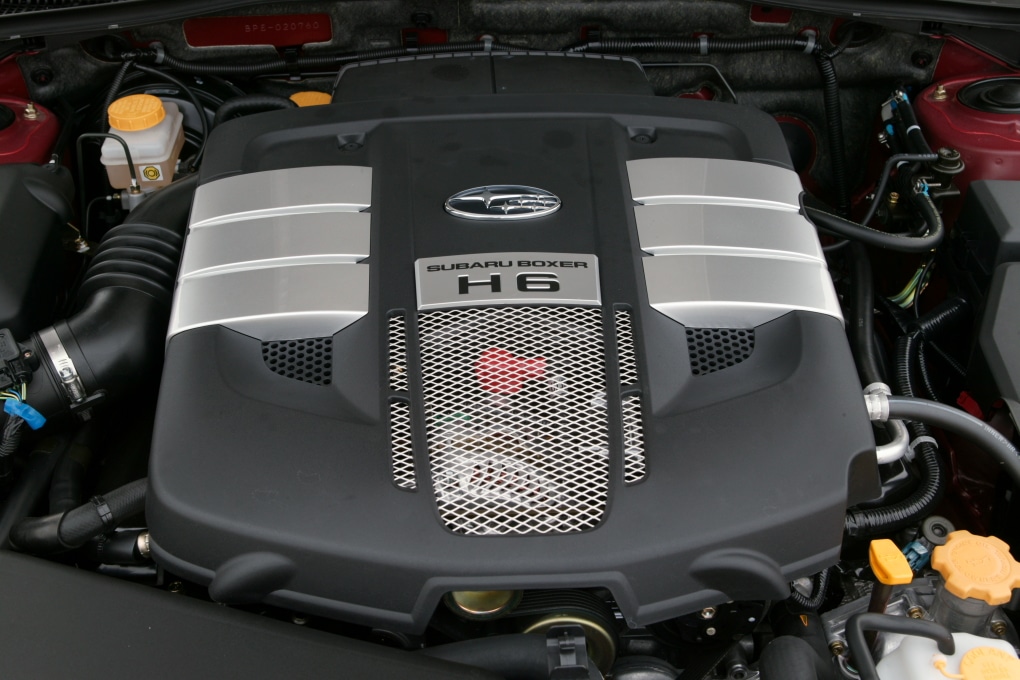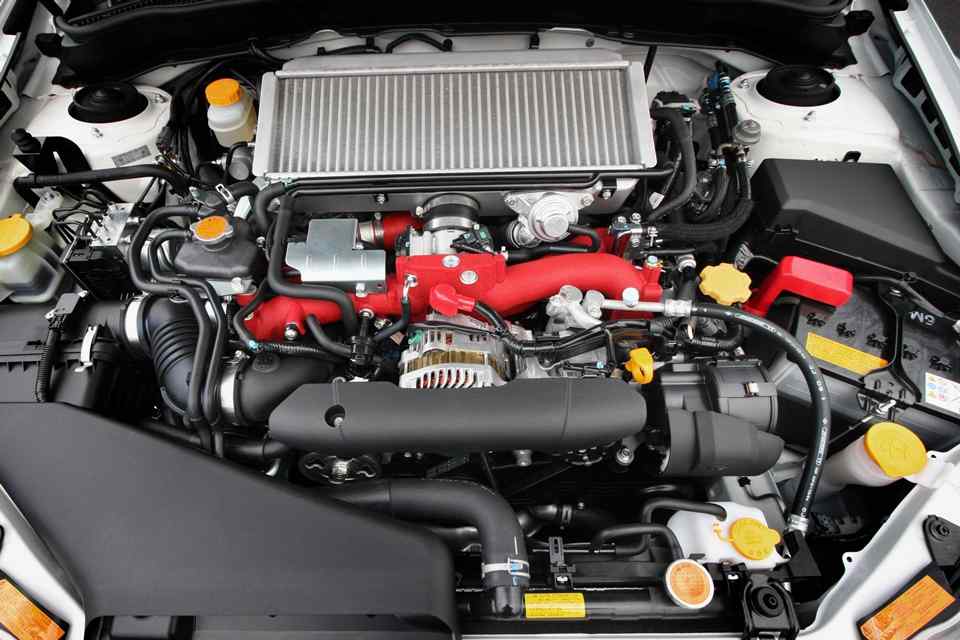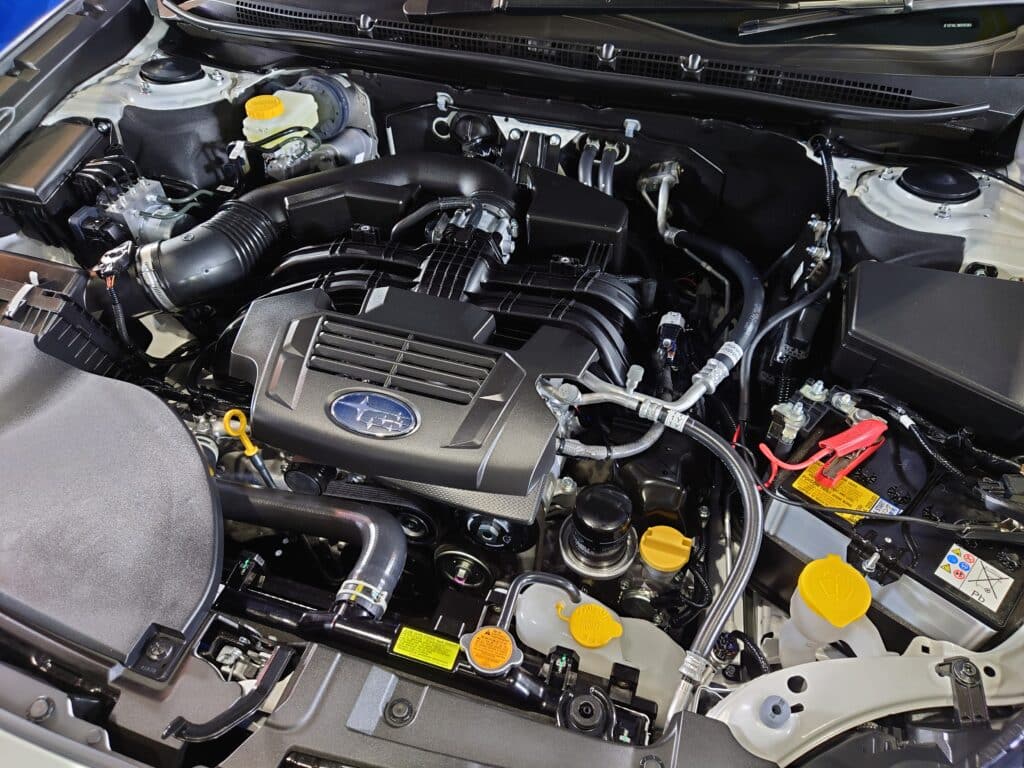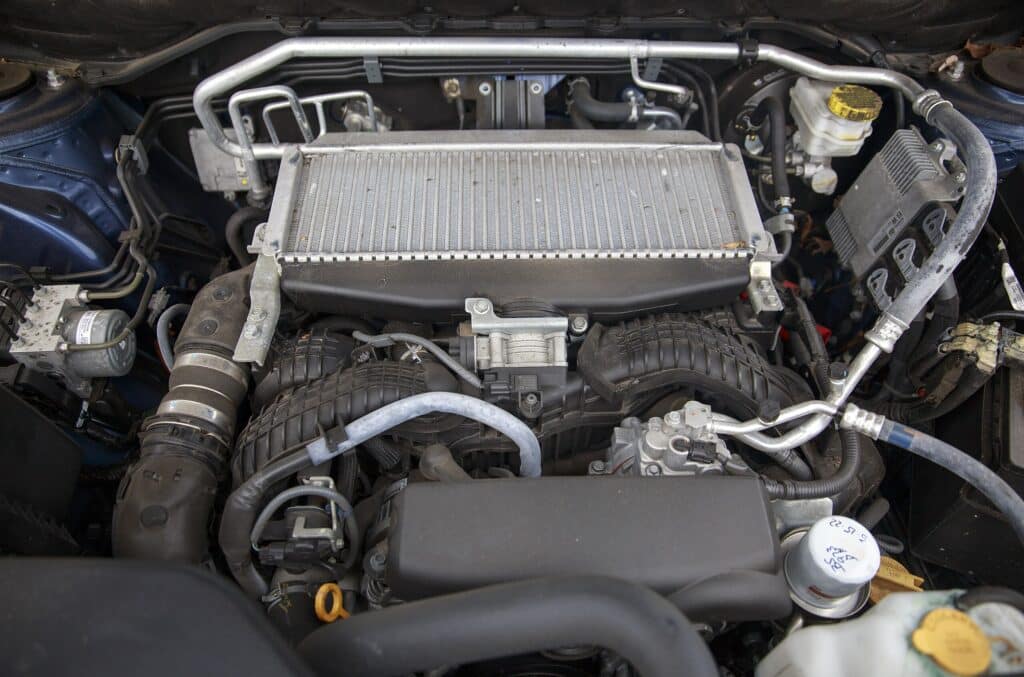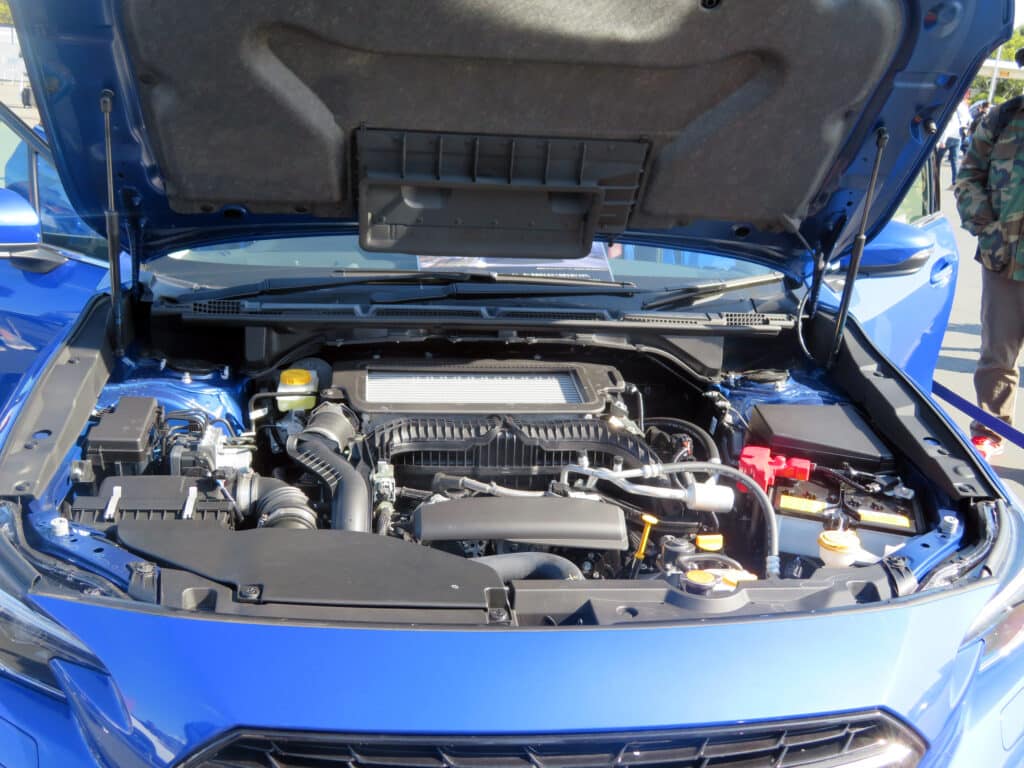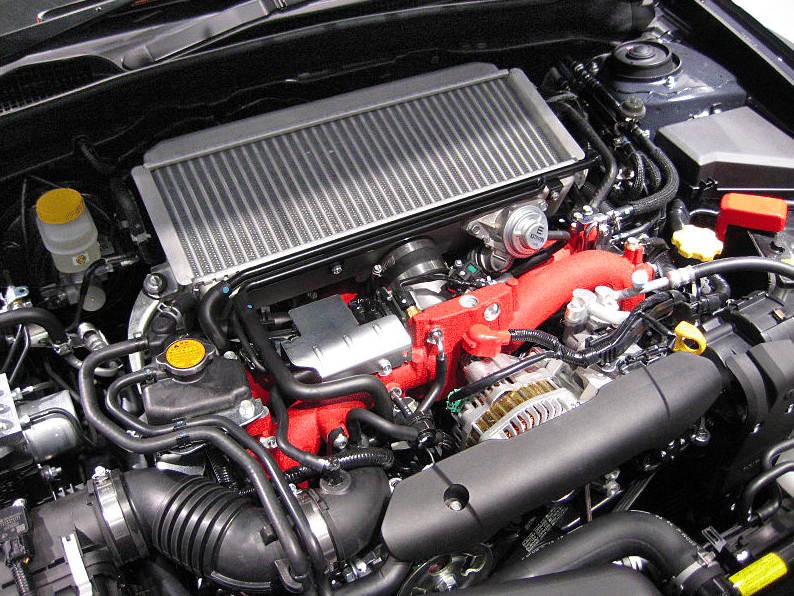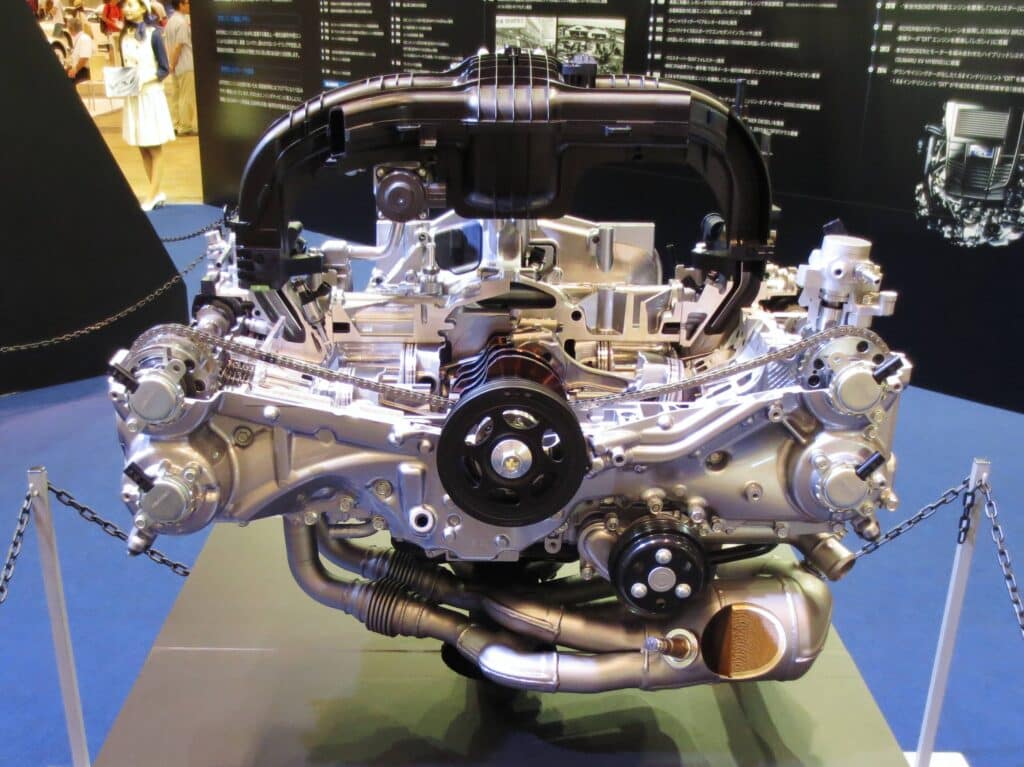
As a seasoned auto enthusiast and writer, my exploration of the Subaru FB25 engine reveals a unit steeped in innovation and practical engineering. Known for its distinguishing boxer configuration, the Subaru FB25 engine debuts a harmonious blend of performance, specs, and reliability that solidified its place under the hoods of popular Subaru models, starting with the 2011 Subaru Forester. Understanding the depth of Subaru FB25 specifications and the enhancements bolstering its performance is paramount for Subaru aficionados and prospective car buyers.
The FB25 engine is part of Subaru’s acclaimed legacy of horizontally opposed engines, a lineup recognized for its low center of gravity and symmetrical power delivery. I’ll dive into the essence of the FB25’s design, scrutinizing its features – from the aluminum alloy block to the advanced dual ‘Active Valve Control System,’ which meticulously orchestrates intake and exhaust timings.
Throughout this journey, we will also tackle FB25 engine reliability, address Subaru FB25 problems and issues that have surfaced over the years, and offer a thoughtful FB25 engine review based on real-world experiences and reputable data.
Key Takeaways
- The Subaru FB25 is a 2.5L boxer engine known for its reliable and fuel-efficient performance.
- Introduced in the 2011 Subaru Forester, the FB25 engine replaced the older EJ253 and features significant design improvements.
- Common issues related to the FB25 include oil consumption, carbon build-up, and cam carrier seal leaks, especially in earlier models.
- Technological advancements in the FB25 contribute to enhanced power delivery and decreased emissions.
- With proper maintenance, the FB25 engine showcases a life expectancy of over 200,000 miles.
- This engine has seen various upgrades, including an increased compression ratio and refined fuel injection systems in later models.
The Evolution and Design of the Subaru FB25 Engine
When discussing the Subaru FB25 engine evolution, reflecting on its breakthroughs and comparing it with its forerunners is important. The transition to the FB25 highlights Subaru’s commitment to optimizing engine efficiency and performance through innovative FB25 engine design and Subaru FB25 upgrades. The meticulous selection of FB25 engine parts underscores the brand’s engineering philosophy.
Comparing the FB25 with Predecessors
My exploration into the Subaru FB25 engine reveals a powerplant undergoing significant refinement over its predecessor, the EJ253. This advancement was not just incremental but strategic in nature, targeting specific aspects of the engine design to achieve performance gains and efficiency improvements. From the block’s structural integrity to the valvetrain’s dynamics, every component incorporated into the FB25 was evaluated and optimized with precision.
The Technological Advances in the FB25 Engine
Frictional losses: One of the most laudable achievements in FB25’s development was the substantial reduction in frictional losses—detailed metrics pinpoint a 28 percent decrease relative to the EJ253. This feat was accomplished using lighter connecting rods and pistons, complemented by reduced piston-ring tension.
Cooling system: The FB25 stands out in its class with a dual-path cooling system. This sophistication ensures optimal thermal dynamics within the engine block and cylinder head and contributes to the environment by lowering emissions. Furthermore, the innovative plastic intake manifold design exhibits minimized pressure loss, promoting a more spirited and efficient combustion cycle.
Emissions and fuel efficiency: With a keen focus on cleaner performance, the FB25 engineers relocated the fuel injectors to the cylinder head, thereby enhancing the atomization of fuel and curtailing emissions. A cooler exhaust gas recirculation (EGR) system complements this approach, further buttressing the engine’s eco-friendly credentials.
Valvetrain: The chain-driven double overhead camshaft configuration in the FB25 not only relinquishes the need for routine timing belt replacement but also underscores Subaru’s dedication to dependability and reduced maintenance.
Manufacturing Processes and Material Choices
Produced exclusively at the Gunma Oizumi factory, the FB25 is a testament to advanced manufacturing and judicious material selection to enhance performance while trimming weight. Lighter pistons, wrist pins, and the advent of roller rocker arms illustrate this intent. Material advancements enabled the later FB25 models to benefit from a slimmer cylinder block, further reinforcing the weight reduction philosophy paired with strength integrity.
- Open-deck aluminum alloy block with a 94.0 mm bore and a 90.0 mm stroke to facilitate increased displacement.
- They engineered asymmetrical connecting rods to maintain engine width while accommodating a longer stroke.
- Introduction of separate coolant circuits for the block and head, optimizing thermal management.
- Transition to chain-driven camshafts bolstering reliability and lowering long-term maintenance.
- Fuel injectors are strategically placed directly onto the cylinder head to improve fuel economy and reduce emissions.
- Lighter pistons and the adoption of aluminum for structural components highlight material efficiency.
The FB25 engine marks a significant evolution from its predecessor, the EJ253, with an open-deck aluminum alloy block construction featuring a 94.0 mm bore and a 90.0 mm stroke. To accommodate longer strokes and maintain engine width, Subaru engineered asymmetrical connecting rods…The new engine offers reduced frictional losses – a 28 percent reduction compared to the EJ253 – largely due to lighter connecting rods and pistons and decreased piston-ring tension.
In conclusion, the Subaru FB25 represents a step forward and a leap in engine design philosophy. It harmoniously balances the need for power and efficiency while never compromising on reliability. The FB25 engine’s substantial upgrades not only enhance performance but also ensure that the engine continues to meet the rigorous demands of both driving enthusiasts and environmental standards.
FB25 Engine Specs
A pivotal element to Subaru’s lineage, the FB25 engine flaunts an engineering maxim of power versus efficiency, a philosophy I find both innovative and admirable. In my analysis, the Subaru FB25 engine specifications crystalize a commitment to performance without sacrificing fuel efficiency, a testament to Subaru’s engineering prowess.
Encased within the sleek contours of this engine is a power plant designed to offer a respectable output ranging from 170 to 182 horsepower, coupled with torque figures varying from 174 to 176 lb-ft—the figures bending slightly across the model years with apparent refinements.
| Manufacturer | Gunma Oizumi Plant |
| Also called | Subaru FB25 |
| Production | 2010-present |
| Cylinder block alloy | Aluminum |
| Configuration | Flat-4 (Boxer engine) |
| Valvetrain | DOHC 4 valves per cylinder |
| Piston stroke, mm (inch) | 90 (3.54) |
| Cylinder bore, mm (inch) | 94 (3.70) |
| Compression ratio | 10.0 10.3 (2014+) |
| Displacement | 2498 cc (152.4 cu in) |
| Power output | 127 kW (172 HP) at 5,800 rpm 129 kW (175 HP) at 5,800 rpm |
| Torque output | 236 Nm (174 lb·ft) at 4,100 rpm 235 Nm (173 lb·ft) at 4,000 rpm |
| Redline | 6,000 |
| HP per liter | 68.9 70.0 |
| Fuel type | Gasoline |
| Fuel consumption, L/100 km (mpg) -City -Highway -Combined | Subaru Forester 2.5 10.9 (21) 6.8 (34) 8.3 (28) |
| Turbocharger | Naturally aspirated |
| Oil consumption, L/1000 km (qt. per miles) | up to 1.0 (1 qt. per 600 miles) |
| Recommended engine oil | 0W-20, 5W-20, 5W-30, 5W-40 |
| Engine Oil Capacity, L (qt.) | 4.8 (5.1) |
| Oil change interval, km (miles) | 5,000-10,000 (3,000-6,000) |
| Engine lifespan, km (miles) -Official information -Real | – 300,000+ (180,000) |
Integral to the powertrain’s low gravity point is its flat-four boxer layout, a signature Subaru attribute that lowers the vehicle’s center of gravity and enhances on-road stability and control. Duly noted should be the laudable Subaru FB25 fuel efficiency, an achievement underscored by its aluminum construction, which plays a pivotal role in weight reduction and, by extension, a smoother driving experience.
Interestingly, the FB25’s anatomy follows a specific FB25 engine firing order of 1-3-2-4, a sequential harmony contributing to its smooth operation and enhanced durability.
The cylinder numbering scheme for the FB25 engine, when looking at the engine from the front of the car, is as follows:
- Left (driver’s side) front cylinder: 1
- Left (driver’s side) rear cylinder: 3
- Right (passenger’s side) rear cylinder: 2
- Right (passenger’s side) front cylinder: 4
For those keen on understanding the operational capacities of this power unit, the FB25 oil capacity is marked at 4.8 liters (5.1 quarts). Moreover, the engine’s lifeblood includes recommendations for top-tier engine oils—API SM/SN rated—fitting within the viscosity grades of 0W20, 5W-30, or 5W-40, per the ILSAC GF-4 or GF-5 standard.
Read Also: Subaru Outback oil capacity
| FB25 Engine Specification | Detail |
|---|---|
| Engine Configuration | Flat-4 Boxer |
| Horsepower | 170 – 182 HP |
| Torque | 174 – 176 lb-ft |
| Firing Order | 1-3-2-4 |
| Timing System | Chain |
| Oil Capacity | 4.8 liters (5.1 quarts) |
| Recommended Oil | API SM/SN (ILSAC GF-4, GF-5) |
| Weight | Varies by equipment |
The essence of the FB25 doesn’t solely reside in the domain of raw output. Its painstakingly calculated architecture coalesces into an engine that is attentive to Subaru’s hallmark of resilience, exemplified eloquently through its valvetrain and balanced boxer posture.
From my perspective, the Subaru FB25 is engineered to bridge the universal driver’s demand for efficacious torque delivery and the quintessential pleasure of a fine-tuned, responsive ride.
The FB25 engine specifications paint a robust picture of an engine resulting from Subaru’s relentless pursuit of perfecting the foil to its automotive ethos: engineering vehicles that fit seamlessly into the dynamic lifestyle of the modern driver while being gentle wards of the environment. Within this balance, the FB25 finds its stride, proving to be a potent heart for the Subaru models it powers.
Diagnosing Common Problems in the FB25 Engine
As an expert delving into the inner workings of the FB25 engine, I’ve identified a trio of issues that stand out in terms of frequency and impact on overall FB25 engine reliability.
Understanding the FB25 Oil Consumption Issue
Among the prevalent issues with the FB25 engine is oil consumption. Oil consumption has been a concern for some FB25 engines, particularly with earlier models reporting higher usage. Estimates suggest up to 7% of these engines may exhibit excessive oil consumption, with manual transmissions being among the most commonly affected.
Subaru’s response has included both component replacements, such as piston rings, and full short-block replacements in certain instances. However, the success of these remedial actions has varied among owners.
- Reports of oil consumption particularly prominent in earlier FB25 engines
- Manual transmissions may be more susceptible
- Subaru’s remedies include piston ring and short-block replacements
- Varied success rates with Subaru’s corrective measures
Identifying Symptoms of Carbon Build-up
The FB25D, employing direct fuel injection technology, faces issues with carbon build-up on the intake valves – a characteristic weakness of direct injection systems. Without the cleaning action of fuel over the intake valves, carbon accumulation can occur, potentially causing engine misfire, hesitation during acceleration, rough idling, and decreased power.
Subaru recommends cleaning the intake valves every 100,000 to 120,000 miles to prevent significant power loss and drivability issues.
I remind Subaru owners that the FB25 engine’s direct injection advantage comes with the caveat of requiring regular maintenance to prevent carbon build-up, which if left unattended, can result in compromised performance.
Dealing with Cam Carrier Seal Oil Leaks
Cam carrier seal oil leaks have emerged as another challenge for the FB25 engine. Subaru has acknowledged the issue with service bulletins indicating that models from 2012 to 2019 Forester, Impreza, and 2015-2019 WRX may be affected. This leak can lead to costly repairs but may not require immediate attention until the severity increases.
- Affected models include 2012 to 2019 Forester, Impreza, and 2015-2019 WRX
- The cost of fixing cam carrier seal leaks can be significant
- Immediate action may not be necessary but should not be delayed excessively
Understanding these three common issues can help owners maintain their FB25 engines more effectively. Regarding Subaru FB25 common issues like FB25 oil consumption and FB25 cam carrier seal oil leaks, early detection and proactive maintenance can mitigate extensive damage and maintain overall engine health.
| Issue | Common Symptoms | Recommended Actions |
|---|---|---|
| Oil Consumption | Higher than normal oil usage, especially with manual transmissions | Check and refill oil regularly, consult Subaru for potential component replacement |
| Carbon Build-up | Engine misfire, hesitation, rough idling, power loss | Clean intake valves every 100,000 to 120,000 miles |
| Cam Carrier Seal Leaks | Oil spots or drips under vehicle, costly repair quotes | Monitor the leak severity, consult service bulletins and plan for repairs |
Maintenance and Longevity of the FB25 Engine
Through my in-depth analysis, it’s become abundantly clear that the success of the Subaru FB25 engine stems from its construction and consistent Subaru FB25 maintenance. With proper care, the FB25 engine’s longevity is noteworthy, often reaching or surpassing the 200,000-mile mark.
The key to achieving such an impressive Subaru FB25 engine life expectancy lies in adhering to Subaru’s recommended maintenance schedule, including timely oil changes every 9,000 miles or annually and regular cooling system checks.
Moreover, my examination of FB25 problems reveals that the non-turbo nature of the FB25 engine pares down the complexity found in turbocharged counterparts, contributing to a straightforward maintenance regimen and fortifying engine resilience. The maintenance-free timing chains incorporated into the FB25’s design are engineered to last for the engine’s operational lifetime, underlining the engine’s reliability and reducing the need for expensive replacements.
In conclusion, as someone who continually observes automotive trends and engine performances, I can assert that the FB25 engine is a paragon of durability within the Subaru lineup. Vigilance in following maintenance protocols, combined with a robust design, makes the FB25 prudent for those seeking a lasting and reliable powertrain.
The upshot for current and prospective Subaru owners is clear: the longevity of your FB25 engine is inextricably linked to consistent maintenance, confirming the old adage that a well-cared-for engine is a long-lasting one.
FAQ
What are the main specifications of the Subaru FB25 engine?
The Subaru FB25 is a 2.5-liter naturally aspirated four-cylinder engine featuring an aluminum alloy block with cast iron liners, double overhead cams, a 94.0 mm bore, a 90.0 mm stroke, and Subaru’s Active Valve Control System. It produces between 170 hp and 182 hp with torque ranging from 174 lb-ft to 176 lb-ft, depending on the model year.
How does the FB25 engine’s design differ from its predecessor, the EJ253?
The FB25 demonstrates significant evolutionary changes from the EJ253, such as an open-deck cylinder block construction, reduced frictional losses due to lighter internal components, and separate cooling circuits for the block and head. It also incorporates technological advances like direct fuel injection and emissions and fuel efficiency improvements.
What technological advances are present in the FB25 engine?
Technological advancements in the FB25 include a plastic intake manifold to reduce pressure loss, separate cooling circuits, chain-driven double overhead camshafts, and direct fuel injection that aids in emissions reduction and increased fuel efficiency.
Are there any notable upgrades in later versions of the FB25 engine?
Yes, subsequent iterations of the FB25 engine have seen upgrades like an increased compression ratio, improved fuel injection placement, and an optimized exhaust manifold design, all contributing to better performance and efficiency.
What is the FB25 engine firing order?
The firing order for the FB25 engine is 1-3-2-4.
Does the FB25 engine use a timing belt or a chain?
The FB25 engine uses a maintenance-free timing chain instead of a timing belt.
What is the FB25 engine’s oil capacity?
The oil capacity for the FB25 engine is 4.8 liters (5.1 quarts).
What type of oil is recommended for the FB25 engine?
The recommended oil type for the FB25 engine is API SM/SN (ILSAC GF-4 or GF-5), and it can be graded as 0W20, 5W-30, or 5W-40, depending on the specific requirements and climate conditions.
How long is the Subaru FB25 engine expected to last?
With proper maintenance, the Subaru FB25 engine has an expected lifespan of around 200,000 miles.
What are common problems encountered with the FB25 engine?
Common problems with the FB25 engine include oil consumption issues in earlier models, carbon build-up in direct injection variants, and cam carrier seal oil leaks affecting certain production years.
How can carbon build-up be addressed in the FB25 engine?
Subaru recommends cleaning the intake valves every 100,000 to 120,000 miles to prevent carbon build-up and associated performance issues in models equipped with direct fuel injection.
What is the recommended maintenance schedule for the FB25 engine?
To ensure longevity and reliability, it’s important to perform oil changes every 9,000 miles or annually, maintain the cooling system effectively, and adhere to Subaru’s recommended maintenance schedule for other services.
Are there specific years or models of the FB25 engine that are more prone to oil consumption?
Earlier models of the FB25 engine have a higher incidence of oil consumption, with manual transmission variants being among the most commonly affected. Subaru has offered remedies, including component replacements and short-block replacements.
Can I expect any major repair costs with the FB25 engine?
While the FB25 is known for its reliability, owners may face major repair costs if issues like cam carrier seal oil leaks are left unaddressed over time. Staying vigilant with maintenance helps mitigate potential costly repairs.

